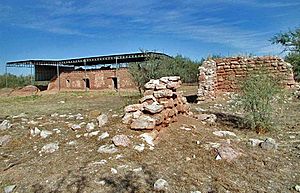Calabasas, Arizona facts for kids
Calabasas means "pumpkins" in Spanish. It was once a small settlement or even a ghost town in Arizona, USA. Today, it's part of Rio Rico, a town near Nogales in Santa Cruz County, Arizona.
Contents
History
18th Century
The Spanish first settled Calabasas in 1756. They built a mission called Mission San Cayetano de Calabazas. About 78 O'odham moved there from their village near the Santa Cruz River. The mission was on bluffs above the river.
In 1772, a church report said 64 people lived at the mission. There were 21 men, 24 women, and 19 children. The report noted the land was good, but the O'odham did not farm much. There was no proper church building or house for the missionary yet.
However, by 1773, a church was ready. In 1775, Father Pedro Font held a church service there. This happened during the first trip by Juan Bautista de Anza to what is now Las Californias.
In 1777, a group of Apaches, some O'odham, and Seris attacked the mission. They burned the church, houses, and a storage building full of corn. The O'odham at the mission fought back. They killed 14 attackers but lost 7 of their own people. The mission was left empty in 1786. The last O'odham left because the Apaches kept attacking.
19th Century
Between 1807 and 1830, the area was used as a farm, or estancia, for the nearby Mission San José de Tumacácori. In 1808, Spanish settlers and Christian O'odham moved back to Calabasas. They fixed up the chapel.
But in 1830, the Apaches attacked again. They burned the buildings and took valuable church items. This made people afraid to live there for over 20 years. However, vaqueros (cowboys) from Tumacácori still grazed cattle nearby.
In 1837, the Mexican government built a fort called Presidio de Calabasas. This fort was meant to protect the area. In 1844, Mission Calabasas and its lands were sold. The buyer was the brother-in-law of Sonoran governor Manuel María Gándara. Gándara started a large ranch there with 6,000 cattle. He even turned the old church into his ranch house.
In 1854, the United States bought this land from Mexico. This deal was called the Gadsden Purchase. The area became part of the New Mexico Territory. Mexican soldiers who were protecting citizens from Apaches left the area in 1856. When they left, Gándara's ranch ended. He then leased the land to the U.S. Army.
Later in 1856, the old mission church, now a ranch house, became a temporary home. Major Enoch Steen and his soldiers, the First Regiment of United States Dragoons, stayed there. They set up Camp Moore at the old fort site. This was the first military base in the Gadsden Purchase area. The new governor of Sonora, Ignacio Pesqueira, allowed supplies to cross into Sonora for the soldiers. With military protection, Gándara's ranch and the surrounding area filled with American settlers.
The next year, Major Steen was ordered to move closer to Tucson. But Steen thought Tucson was a bad influence on his soldiers. So, he moved his camp 25 miles (40.2 km) northeast. The new base was named Fort Buchanan, after President James Buchanan. After this, the old mission buildings were used for different things. They were a customs house in 1857. A family, including Larcena Pennington Page, lived in the ranch house before September 1859.
In January 1861, Apaches attacked Johnny Ward's ranch near Calabasas. They stole cattle and took his stepson, Féliz Martínez. Ward went to Fort Buchanan for help. Lieutenant Colonel Pitcairn Morrison sent soldiers led by Second Lieutenant George Nicholas Bascom. This event, known as the Bascom Affair, started the Apache Wars. These wars lasted for over 20 years.
The American Civil War began in April 1861. At the same time, Apache attacks increased. U.S. troops in Arizona were ordered to leave and go east. To stop Confederate soldiers from using it, Fort Buchanan was burned. Camp Lowell, near Tucson, was also left empty. The Apaches thought they had won against the Americans. They took things from the empty forts and raided more in the Santa Cruz Valley. Most mines, ranches, and towns had to be abandoned. Only Tucson, Sylvester Mowry's silver mine, and the Pete Kitchen Ranch held out against the Apaches.
In September 1865, soldiers from the California Volunteers moved to the old Camp Moore at Calabasas. It was first called Post at Calabasas. Then it was named Fort Mason after General John S. Mason. The 1st Battalion of Native Cavalry, California Volunteers and the 7th Regiment California Volunteer Infantry stayed there. U.S. Army troops took over in May 1866. But many soldiers got malaria. So, the Regulars left Fort Mason in October 1866. They set up a new camp called Camp Cameron.
By 1878, Mission Calabazas was completely abandoned and in ruins. Only a shell of the building with no roof remained.
Site Today
Today, you can still see parts of this old settlement. The original Mission site is one place. It was a farm, a ranch, a fort (Fort Mason), a customs house, a post office, and a home. Now, it is protected and part of the Tumacácori National Historical Park.
There is also the site of the Mexican fort, Presidio de Calabasas, built in 1837. This land looks empty now. The Calabasas Cemetery is also there. Soldiers from Fort Mason started it during the Civil War. Later, local people used it too.
Other old Calabasas village sites and the Calabasas Store are now covered by modern buildings in Rio Rico. The Santa Rita Hotel was once a nice hotel along the railroad to Mexico. It is now an empty piece of land near the old train tracks. It is south of Sonoita Creek and east of where it meets the Santa Cruz River.


